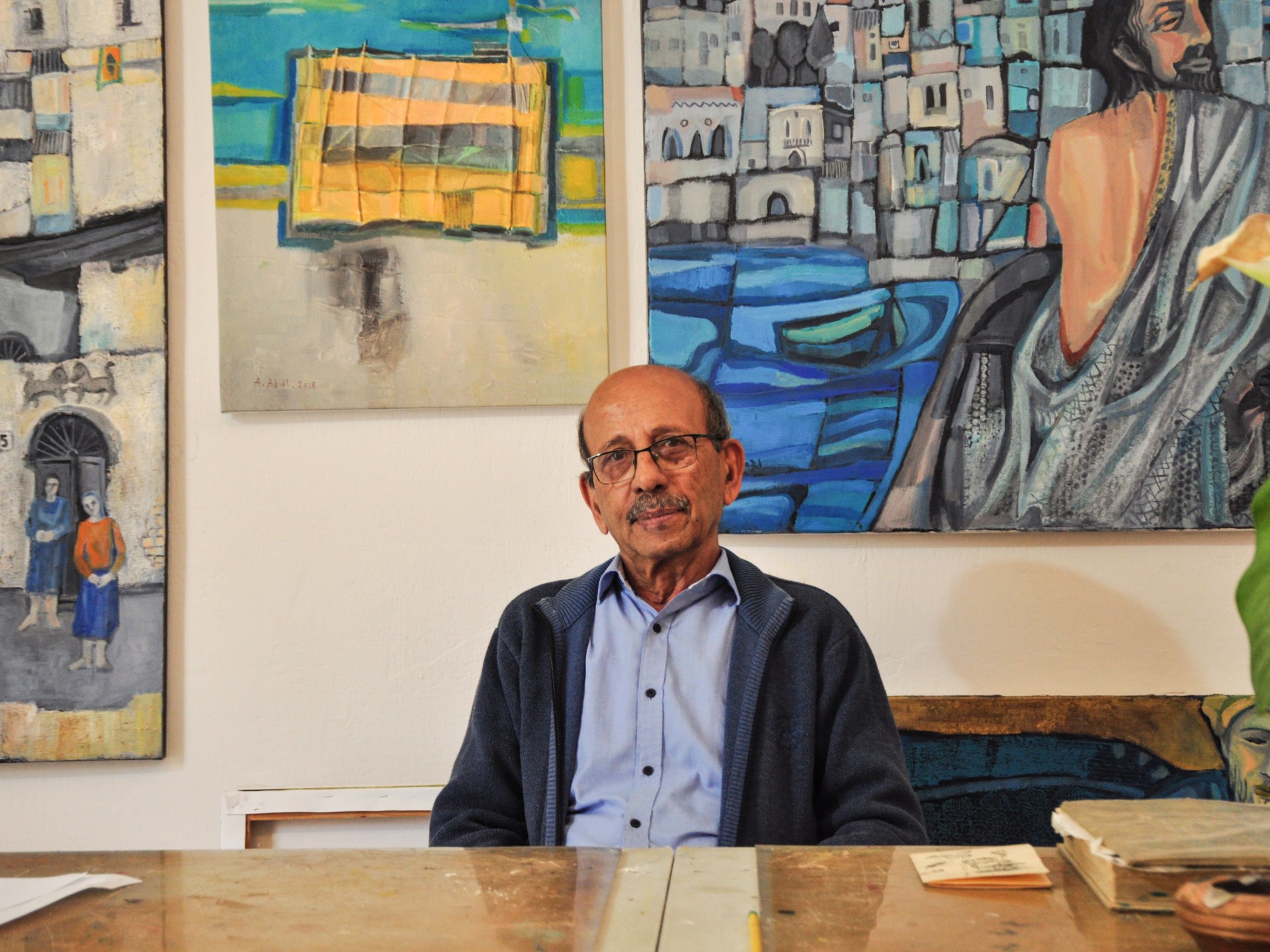
Wadi Nisnas, Haifa – Visual artist Abed Abdi was expelled from Haifa – a major port city on the Mediterranean Sea – along with tens of thousands of fellow Palestinians by Zionist militias in 1948.
Memories of displacement and dispossession that started at age six inspire the art Abdi produces even today, at 81 years of age.
“Those scenes are very painful,” Abdi tells Al Jazeera from his art studio, located at the edge of the neighbourhood of Wadi Nisnas on the northern outskirts of Haifa.
“My memory of those moments is like a treasure to me,” added Abdi – a soft-spoken, meticulous man. “I remember the masses of people at the Haifa port. I remember the suffering of the people.”
On April 22, 1948, three weeks before Israel was declared a state, Abdi was forced to flee from the neighbourhood of Wadi Salib in Haifa with his mother and four siblings due to intense shelling by Zionist militias and attacks on residents.
More than 750,000 Palestinians were forcefully displaced from their homelands as Zionist militias went on a rampage, killing Palestinians and destroying their society and homelands in 1948.
At least 110 Palestinian men, women and children were slaughtered in the Palestinian village of Deir Yassin on April 9, 1948, and Zionist militias killed 60 to 70 Palestinians in the Balad al-Shaykh village, 7km (4 miles) east of Haifa city months prior.
Palestinians observed the 75th anniversary of the organised and violent ethnic cleansing of Palestine – which is marked as Nakba, or catastrophe – on May 15, 2023.
“Most of Haifa’s residents took to the port for shelter, thinking that it could save them. Even if they would be away for a week or two, they would be back,” says Abdi, who returned to his homeland three years later.
“Some people carried their mattresses with them. My mother took cooking tools such as her mortar, even though it was heavy. We took it and came back with it. She also asked someone to carve her name into one of her pots that she took with her,” Abdi continues.
His father managed to remain in Haifa during the cataclysmic events. After three years in refugee camps across neighbouring Lebanon and Syria, Abdi, his mother and three of his siblings became one of the few Palestinians allowed to return to their city for family unification in 1951.
Between December 1947 and April 1948, the Zionist forces expelled more than 95 percent of Haifa’s Palestinian residents. Originally a city of some 75,000 Palestinians, only 3,000 to 4,000 of them remained after the Nakba. The rest became refugees, mainly in neighbouring Lebanon and Syria, and they are barred from returning to this day.
Those who remained were concentrated in the neighbourhood of Wadi Nisnas and prevented from returning to their homes or retrieving their property.
“Our suffering continued – we returned to hardship and a hostile environment. The homes and properties of the Abdi family owned were all confiscated. My father moved into his aunt’s house, the ownership of which also went to the state,” he says.
“I was in a situation where I realised it was critical for me to activate my visual memory,” says Abdi. During his time in refugee camps, he recalled one attempt to displace his family again.
“I remember, and my sister Zahra remembers, there was an attempt to evict us or displace us once again, in a truck, to Baghdad. We escaped from the camp and we went to my sister Lutfiyeh’s house in Damascus.”
At 22, Abdi moved from Haifa to Germany, where he was accepted into a visual arts school. Upon his return in 1972, he found that “there were few Palestinian artists”, he says. “I was in an environment where people were struggling for bread, not for creativity and nonessentials.”
Abdi worked as the chief graphic designer and illustrator of Al-Ittihad newspaper based in Haifa and Al Jadid literary journal – two key publications in Palestinian society at the time – for more than a decade, starting in 1972.
He drew illustrations and prints for notable names in the Palestinian literary scene at the time, including Emile Habibi, Toufiq Zayyad, Samih al-Qassim, Mahmoud Darwish and Salman Natour.
Besides producing countless pieces of art exhibited around the world, Abdi also gave art courses and workshops in Palestinian towns across Israel including Shefa-Amr, Kufr Yasif and Daliyat al-Carmel.
“I work towards creating a new cadre of Palestinian artists,” says Abdi, explaining, “It is important the new generations understand fully the truth of our expulsion from our city Haifa in 1948.”
"artist" - Google News
May 29, 2023 at 07:55PM
https://ift.tt/SNKnlDB
Photos: Memories of Nakba inspire Palestinian artist’s work - Al Jazeera English
"artist" - Google News
https://ift.tt/bGq2ohK
Bagikan Berita Ini














0 Response to "Photos: Memories of Nakba inspire Palestinian artist’s work - Al Jazeera English"
Post a Comment